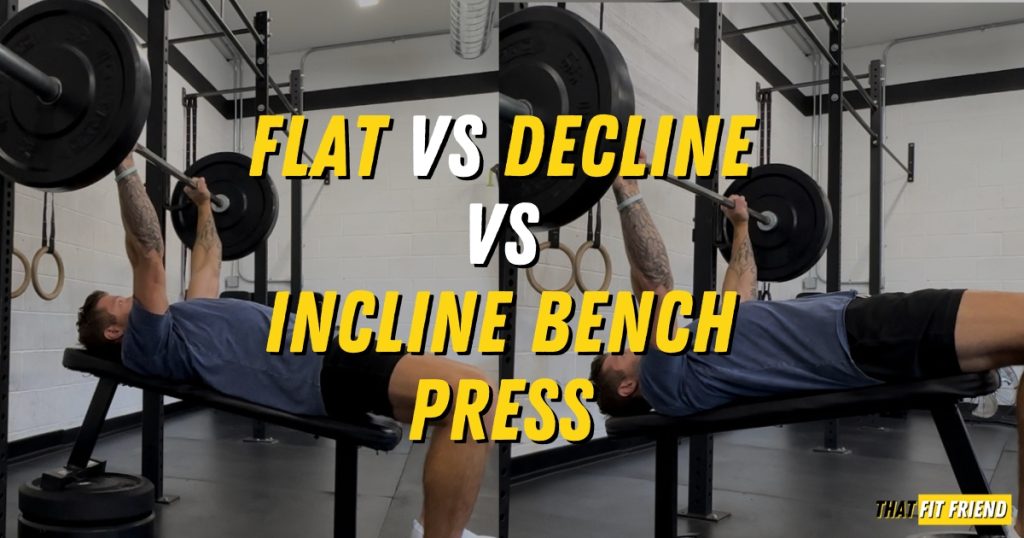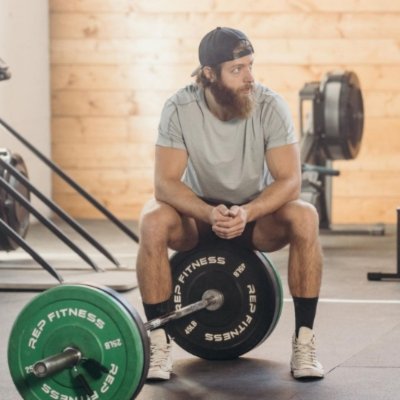Every barbell bench press variation has a special place in my heart. I feel like I remember an exact moment in time when I was equally obsessed with the incline, flat, and decline bench press for whatever reasons.
When I was struggling with a shoulder tweak from college cheerleading, I got super into decline benching, and when I wanted bigger delts I was programming incline all of the time. Then, of course, you have flat, which is my constant rock for building horizontal pressing strength.
In my coaching opinion, it’s a good idea to familiarize yourself with all of the barbell bench press variations. Each variation can be useful at different points in time depending on your goals and understanding the “when” to use each is important.
To build the girth of the pecs, the flat bench press can be a great option. For the upper pecs and the anterior delts, opt for incline bench presses, and to build the bottom of the pecs, program the decline bench press.
Which Variation Is Best? It Depends.
When discussing which bench press variation is “best” or “better” we need to apply context to what we’re asking. For example, the flat, decline, and incline bench presses will be better than one another depending on your goals.
This is why I don’t love the idea of “better” or “best” as that language with exercise selection is typically shortsighted. Below are a few goal-specific contexts where each of these bench press variations can be better than the others.
The Flat Bench Press Can Be Better If…
- Your goals revolve around improving your horizontal pressing strength. If you want to build general pressing strength, then this variation will be a really good choice.
- You’re a powerlifter or want to compete in powerlifting. The flat bench press is a competition lift that you’ll need to program and practice often to be successful.
- Your goals revolve around building the sternal pec fibers AKA the middle pec fibers. The flat bench will give you the “most” regarding overall pec involvement.
The Incline Bench Press Can Be Better If…
- Your goals revolve around building the clavicular pec fibers AKA the upper pec major fibers.
- You want to blast the anterior delts and you want more carryover to your overhead press. By doing higher incline bench presses you can sometimes improve your overhead pressing strength as well.
- You want to work through a deeper range of motion to improve your shoulders’ abilities to press from different angles.
The Decline Bench Press Can Be Better If…
- Your goals revolve around building the costal pec fibers AKA the lower pec fibers. If you need more girth in your lower pec, then opt for decline bench presses.
- You want to expose yourself to a different pressing range of motion to ensure you can be strong pressing from a wide range of angles.
With that in mind, the flat bench press will be your most “generalist” of these three bench press variations. The incline bench press is typically the second most popular option to perform and the decline press is the most specific and often least used.
Differences to Know
Whether you’re programming for yourself for the first time or you’re brand new to bench pressing, it’s a good idea to familiarize yourself with some of the differences between these bench press variations.
Difference 1: Angle of the Press
The first and most foundational difference between the flat, incline, and decline bench presses is that each variation will entail a different bench pressing at a different angle.
The incline bench press will entail bench pressing on an incline bench. The amount of incline can vary depending on your equipment. As a general rule of thumb, if you want more delt involvement press on a higher incline, and for more pec, press from a lower incline.
The flat bench press will have you press from a flat bench. This is the most basic variation of these three and it’s a good option for beginners starting to learn the bench press and lifters that want to build their pecs in totality.
The decline bench press will entail pressing from a decline bench angle. The level of decline can vary like the incline bench press, however, to a lesser degree and you’ll typically only decline bench press from a 15 to 30-degree angle tops.
Difference 2: Pec Fibers Being Trained
Another difference is the muscles, and more specifically, the pec fibers that each variation will help train. A large reason for using flat, incline, and decline bench presses is they can be great for biasing the different muscle fibers of the pec major.
When thinking about training the pecs, I break them into three different divisions and these include the sternal pec fibers, clavicular pec fibers, and costal pec fibers. Each of these bench press variations will train these divisions of pec fibers to different degrees.
- Incline Bench Press: Useful for training the clavicular pec fibers (upper pec), anterior delts, triceps, and sternal pec fibers to a lesser degree depending on your incline bench angle.
- Flat Bench Press: Useful for primarily training the sternal pec fibers (middle pec), and anterior delts, triceps, and you’ll also get some costal and clavicular pec depending on your setup and mechanics.
- Decline bench Press: Useful for training the costal pec fibers (lower pec), triceps, and anterior delts.
It’s important to keep in mind that your bench press angle can influence “how much” you’ll be training certain pec fibers and your setup and execution can also influence your abilities to train these fibers as this can influence the range of motion you’re working through.
Difference 3: Skill Requirements
The third difference that I want to touch on in this article is the skill requirements that come along with the flat, incline, and decline bench press. This can be an important difference to consider for beginners and intermediate lifters.
For beginners, I typically recommend tackling the flat bench press first and building a good foundation with this press. The flat bench press is the most “generalist” of these three bench variations and you’ll train a majority of the pecs with the flat bench.
This can be great because it will give you a better understanding of horizontal pressing mechanics and as you begin to hypertrophy your pec fibers more you’ll start to see what might be lagging which can then lead you to programming incline and decline presses.
Despite suggesting that most lifters start with the flat bench press, the decline bench press typically “feels” the easiest to perform. You’ll usually work through a smaller range of motion with this variation.
Plus, the unrack and press tend to be a little easier to master as well. And speaking of racking, if you’re training alone, then it’s often easier to rerack a heavy decline bench press compared to an incline and flat bench press.
The incline bench press is arguably the toughest of these three variations and that’s due to the range of motion you’ll be working through. The incline bench has a larger range of motion you’ll have to press through and you’ll need a good level of mobility to perform these.
All that said, master the flat bench press first and your life will be a lot easier when you start learning and implementing the incline and decline bench press into your workout program.
Muscles Trained
All three of these bench press variations will train the pecs, triceps, and anterior delts to various degrees. For the sake of getting a little more granular in this article, I’ll highlight which pec fibers each variation typically trains more of.
Remember, your pressing mechanics and bench press setup can influence “how much” you’re training the muscles listed above. When in doubt, run a variation for a full block to accurately track progress to see what works best for you.
Why Perform Them In Your Workouts
When clients ask me about the “why” behind each of these bench press variations in their workout programs, I’ll typically list three benefits of performing each variation.
Benefit 1: Improved Pressing Strength
Regardless of the bench press variation you’re performing, you’ll be improving your pressing strength to various degrees. If your goal is building well-rounded pressing strength, then utilizing all three variations can be useful.
In most cases, when we think about pressing strength, we think of horizontal pressing AKA the flat bench press. However, the incline bench press and decline bench press can also be great for improving our ability to press from different angles.
If you play sports or just want to be stronger with your pressing strength in general, then it’s never a bad idea to give yourself exposure to pressing from different angles.
By pressing from different angles you’ll improve your pecs’ strength capacity and abilities as a whole and be better suited to produce pressing force in a wider range of contexts.
Benefit 2: Build Fuller Pecs
On top of building well-rounded strength, you’ll also build fuller pecs by implementing flat, decline, and incline bench presses into your workout program. If your goals revolve around building your pecs, then you’re likely well aware of where you might be lagging.
In many cases, it’s typically the middle and lower pec that are typically lagging for lifters. If we can understand what pec fibers we need to train more of, then we select the bench press variation that will suit our needs best.
As you bench press more, it’s a good idea to give yourself exposure to all three bench press variations from time to time to ensure you’re not leaving any pec fibers undertrained.
No one wants to be the lifter with super-built-up upper pecs but lagging lower pecs that lack mass and girth. When in doubt, use all three variations strategically to train the different pec fiber divisions.
Remember, these bench press variations also train your triceps and anterior delts to various degrees, so they can all be great for building upper body mass in general.
Benefit 3: Bulletproof Upper Body Tissues
Outside of just focusing on muscle fibers and their hypertrophy, the flat, incline, and decline bench presses can be great for strengthening the connective tissues of the upper body as well.
I liken these three bench press variations to squatting through different ranges of motion. When we expose ourselves to different ranges of motion we’re going to train the tissues used in those ranges to be more resilient.
For example, you don’t want to be the lifter that has a big flat bench press but then has aches and pains in their upper body the moment they press from an incline and decline.
With strategic progressive overload, the flat, decline, and incline bench presses can help build a more resilient upper body and improve the capacity of the connective tissues around the pecs, shoulders, and triceps.
Coach Jake’s Bench Press Comparison Takeaways
- Takeaway 1: If you want to build the pecs in totality and train all of the fibers that make up the pec major, then you’ll want to program and utilize all three of the bench variations.
- Takeaway 2: If you notice that your pecs are lagging in any one area, then I’d suggest increasing the volume of the bench variation which will help facilitate the growth of the fibers that need attention.
- Takeaway 3: Of these three bench variations, the decline bench is the least popular to perform, and in most cases, I find that it’s the variation that could be more easily replaced with cables and dumbbells.
Final Thoughts
The flat versus incline versus decline bench press topic is a fun one to navigate, especially when it comes to programming goals. All three of these bench press variations can be beneficial for different reasons.
If your goals revolve around building well-rounded pressing strength and pec mass, then it’s a good idea to practice and utilize all three of these variations.
If you have additional questions about the flat, incline, and decline bench press, drop a comment below or reach out via Instagram (@jake_boly or @that_fit_friend).





















Joe Zuromsky
Hi Jake
I’m a 68 year old lifter with a lot of experience. I lifted for about 30 years then took 10 years off and I’m back at it again. What kind of workout routine would you recommend?
Sincerely
Joe
Hey, Joe! Honestly, I’d try to find something that focuses on basics in the context of getting you pressing, squatting, pulling, rotating, etc. Finding a coach for at least a month or two of programming would also be my advice as they can help with direction and dialing in your form before you go off on your own. I don’t have any templates that I feel comfortable suggesting out of the blue without context!